For spring break this year I joined a group of adventurous students and traveled to Shenandoah National Park for a week of backpacking in the Appalachian Mountains. Our crew included people from a variety of backgrounds, including some who were brand new to backpacking and camping, and a few experienced hikers and backpackers. To prepare for the trip, we took a weekend trip to Turkey Run State Park for a “shakedown” hike. The trip gave everyone an opportunity to try out their gear and make sure everything fit properly. I’ve acquired a few new items since last season, including a Mariposa 60 backpack and an REI Igneo sleeping bag. I was very happy with how the pack performed, even loaded over its maximum recommended weight of 35 pounds.
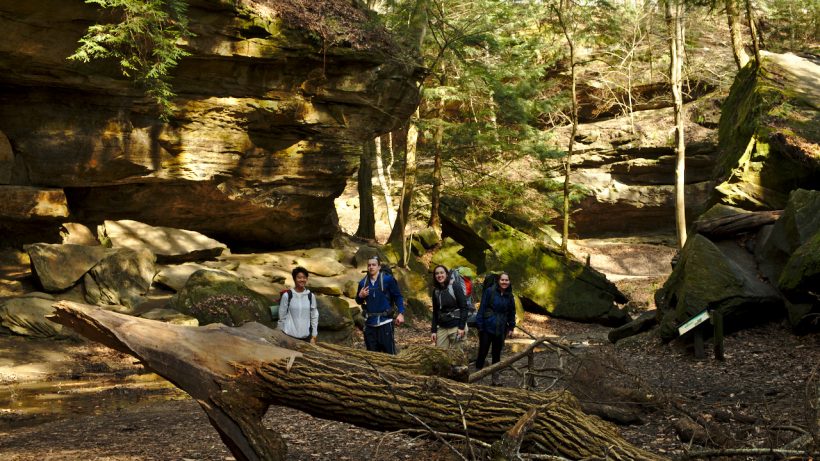
To prepare for the trip, we donned (mostly) full packs and spent a few hours trekking through the beautiful canyons of Turkey Run State Park
Cedar, our fearless trip leader, also taught us the proper techniques to hang bear bags while minimizing tree damage. It’s been many years (eight or nine?) since I last hung a bear bag, so it was a good review and I learned some new tips and tricks! We all tried our hand at throwing the line over a high tree branch. It proved to be more difficult than expected.
Trip Planning
There are two stellar maps available for planning trips in the Central District of Shenandoah National Park: the National Geographic Map and the PATC #10 Map. Note that the Nat Geo map has distances marked on the map between landmarks and trail intersections but the PATC map does not. However, the PATC map is more detailed and is geared specifically to backpacking.
Prep: Food for a Week of Backpacking
In the time between our shakedown hike and the trip, I planned and packed my food for the week. Other than the usual energy bars and trail mix, I tried a few new recipes. For breakfast, I packed granola with dehydrated milk (or dehydrated coconut milk – yum!). I also added a scoop of whey protein powder to add some much-needed extra protein to the menu.
I packed two different lunches. The first is a gold standard: tortilla, peanut butter, and dried fruit. I’m partial to dried apples because I can use them to scoop out the peanut butter. My other lunch option is one I tried out last summer in the Sierras: flat bread, hummus, and cheese. You can order powdered hummus online; it’s really simple and only requires water. I packed pepper jack cheese sticks for some extra flavor and calories.
I also packed two separate dinner options. One delicious option is a recipe I found on TrailCooking.com: Couscous, tuna, balsamic vinegarette, and lemon pepper. I added a few dehydrated veggies to add extra nutrients and made sure to use tuna packed in olive oil to maximize the number of calories. The other dinner meal is a backpacking classic: mashed potatoes! To increase the protein content and number of calories, I dehydrated black and kidney beans. Each dinner included four servings of mashed potatoes and an entire can of beans… There’s no point skimping when you’re going to be walking all day! When you combine those meals with a generous number of snacks, I averaged about 3500 calories per day.
As spring break approached, I checked and rechecked the weather forecast. A few weeks ago, the forecast more or less mirrored the annual averages: highs in the upper 40’s and low 50’s, with lows in the upper 20’s. The most current forecast before the trip predicted much lower temperatures with several nights in the teens and the possibility of snow. We went regardless, of course.
The drive to Shenandoah takes a little over 10 hours from Indiana. Despite an early start, we didn’t arrive at the trailhead until well after dark. Rather than hiking down the trail in the dark to set up camp, we decided to spend the night sleeping in our cars. It was a little crowded and very uncomfortable, but we managed and everyone woke up the next day ready to begin a spring break adventure!
Day 1 – Trek to Nicholson Hollow
March 12, 2017 | 8.91 mi | +1702′ / -3269′
I wake up after a pretty restless night in the driver’s seat of my car. I’ve reclined the seat as much as possible without squishing my friends sleeping in the back seat and am cocooned in my sleeping bag. I slept in my hiking gear and am pretty cozy despite the early morning temperature of 16 degrees (F). I’m wearing compression shorts and a compression shirt as a base layer. Full-length leggings and olive green nylon pants make up the rest of my layers on the bottom. On top, I’m wearing a fleece quarter-zip and a bright green down puffy jacket. A fleece hat, fleece gloves, synthetic liner socks, and wool hiking socks cover my extremities, and I have a windbreaker/rain jacket in reserve for a little extra insulation.
After extracting myself from my sleeping bag, nature calls and I head down the trail a little ways to find a spot to dig a cat hole. The rest of the crew begins to wake and we cook breakfast in the parking lot next to the cars. Hot food is refreshing in the freezing morning air, though it doesn’t do much to ease the painful numb feeling in my feet. Socks and shoes just don’t do much to keep my feet warm; the only remedy is to get walking!
Our trip itinerary this week is based on the Central District Highlights circuit route designed by the National Park service; they have an entire list of suggested itineraries! Today we will visit a waterfall and a cave, do some ridge walking, and generally enjoy the sights and sounds of the forest. Our route is a little less than 9 miles and is mostly downhill. The Meadow Springs parking lot we’re at now is near the top of a ridge line and our campsite tonight in Nicholson Hollow is several thousand feet lower. Of course, everyone’s packs are at their heaviest right now, and we’ll all soon discover whether or not we overpacked…
After taking a group photo at the trailhead, we begin our trek! Thankfully, feeling returns to my feet after some walking and the rising sun warms our bodies and spirits. Everyone is all smiles and we even shed a few layers during the steady descent from Skyline Drive into the wilderness of Shenandoah National Park.
After a few short miles, we reach a spur trail that drops from a ridge to a small creek. The map and guidebook identify a cascade here as well as a cave, so we head down to check it out. The cave and cascade are small but still neat. While admiring the sights, we refill bottles and purify the water in preparation for the miles ahead.
Of course, the downside of leaving the trail on the ridge to check out the cascade and cave is that we have to climb back up to the ridge. Oh well! Once we return to the main trail, our path follows the ridgeline for another mile, offering views of the surrounding landscape. Fallen leaves carpet the trail; from the looks of things, it could just as easily be November as March!
Descending from the ridge is made more exciting by the slippery leaves; there are a few spots where my downward progress is more accurately described by “leaf surfing” than “walking.” At the bottom of the slope is a small river with plenty of rocks to hop across on. Trekking poles are useful for some, but I prefer to cross quickly; it’s always more difficult to balance if you stop on each and every rock.
From the valley, there’ s only one direction to go: up. We begin a steady climb with Hazel Mountain on the left. Cedar identifies plants as we go and points out a shrub called Witch-Hazel, after which I assume the nearby peak is named. We take a break and eat lunch in the middle of a particularly long uphill segment. The rest and influx of calories revitalize the group and soon we’re on our way again!
I predict the top of the ridge incorrectly several times before we actually reach it, much to the chagrin of the hikers behind me. However, from this ridge, it’s pretty much all downhill until camp (see the elevation profile above)! We reach several trail junctions in the next mile or so and take care to identify the proper path that will lead us to Nicholson Hollow.
The trail passes through some beautiful green tunnels formed by conifers and small shrubs defying the forest’s hibernation. I fall to the back of the group a few times to snap photos and then hurry to catch back up. I can only imagine what these trails must be like in the spring once the leaves arrive! And Autumn… I’m going to have to return in autumn to see the fall colors.
After a few more hours of hiking, we arrive in Nicholson Hollow. There are plenty of great campsites available, many with downed trees arranged in circles for sitting and for tents. Nearby, rock walls run along the hillside, likely from the early mountain people that lived here. We set up our tents and plop down on the ground to cook dinner. Soon the sounds of hissing stoves and bubbling water fill the air as water boils and is combined with dehydrated meals. Food, especially hot food, is always wonderful after a long day of hiking!
The final task of the day before we can relax and go to sleep is bear-proofing the camp. All scented items must be removed from your person, tent, and backpack and stashed in “bear bags.” We have a variety of bear bags; I’m using a dry bag, others use sleeping bag stuff sacks or daypacks that are otherwise unused during the night. The bear bags must then be hoisted up into the air, at least 10 feet off the ground and 5 feet from the nearest tree trunk. Locating a tree with branches to facilitate this kind of setup proves a tad difficult. Many of the trees don’t have horizontal branches anywhere near the ground. To make the task more fun, daylight is quickly fading. After several attempts, two ropes are hung over branches and, by the light of a single headlamp, we tie our assortment of bags to the ropes and hoist them up into the air. The ends of the rope are then tied off on a nearby tree.
Once bear bags are up, we settle down for the night. I purify some water gathered from the nearby Hughes River so that I don’t have to in the morning when it is cold and I’m hungry. Hiker midnight (9 pm) arrives and the group heads to bed. One thing I particularly enjoy when living outdoors is the opportunity to synchronize your schedule with the sun – once darkness falls, there’s not much left to do but sleep!
Day 2 – Old Rag and Big Rocks
March 13, 2017 | 10.21 mi | +3092′ / -3120′
I must say, sleeping in a tent sure beats sleeping in a car. While it was definitely a little colder in the tent, I vastly prefer sleeping on the flat ground to the lumpy car seats. I got up once in the middle of the night to relieve myself and was amazed at how bright the full moon was. The trees cast sharp shadows in the moonlight and I didn’t even need my headlamp to see where I was going.
This morning is another sunny one and although it is quite chilly (about 16 degrees again), I feel warmer because of the friendly light. Another benefit of the warm morning light is great photos! I brought my camera (duh) and have been snapping away to my heart’s content. I’m trying out a new setup with my camera gear. On previous trips, I’ve carried a camera in a holster attached to the hip belt. However, my new Mariposa pack has hip belt pockets that I don’t want to cover up, so I’ve rigged up a Zpacks pouch to the front of my pack and stash the camera in there. It’s easy to grab and doesn’t bounce around too much. I also bought a 10,000 mAh battery pack to keep the battery full. Technically, it would be lighter (less mass) to pack four or five fully-charged batteries for the camera, but the battery pack gives me the flexibility to charge other devices as well.
Today’s plan is to summit Old Rag and then return to Nicholson Hollow. To avoid leaving a trace, we’ll move our campsite further downstream. We’re also going to leave most of the heavy gear – tents, sleeping bags, most of our food – at camp and summit with day packs. We have a few more miles to cover today than yesterday, and a not insignificant amount of elevation to conquer, so once breakfast is over, we hurry to pack up camp and move it downstream. There are plenty of other sites available, and we’re soon set up at another beautiful spot. I didn’t bring a day pack, but my backpack serves just as well. I bring along some snacks, lunch, water, emergency gear, and my photography equipment.
The first several miles are relatively flat and we exit the national park for a short while and walk up to a parking lot at the Ridge Trail trailhead. Old Rag is a popular hiking spot and we encounter lots of other hikers out enjoying the beautiful day. The easy hiking ends at the trailhead. Soon we’re heading up, up, up into hills. Massive boulders are littered around the landscape, foreshadowing the rocky terrain to come on the ridge and approach to the summit.
After turning the corner onto the ridge of Old Rag, the trail transforms from switchbacks to a sequence of bouldering problems. There are sections where you must carefully place your hands and feet to avoid slipping into a crack. None of the falls are huge or particularly dangerous, but it’s not outside the realm of possibility that careless hikers might break a leg or sprain and ankle.
We traverse some fun and challenging terrain and reach a flat spot with terrific views of the country to the East of Old Rag. We stop to take pictures, admire the views, and drink some water.
The trail continues to wind between massive rock faces, over and under boulders, and sometimes right through the mountain where the rocks have fallen to create little tunnels. The bouldering, while slower going than regular hiking, is great fun!
Patrick Wilson, the pineapple that has been traveling with us, meets his end when we reach the summit. Cedar carried him yesterday, and I’ve been toting the little guy around in my back today. He has reached the perfect ripeness, so we elect to eat him on the top of Old Rag. The delicious pineapple (best I’ve ever had, hands down), combined with lunch and the glory of summiting the mountain, makes for quite an afternoon!
Traversing the rest of the Old Rag ridge involves some more bouldering, but we soon reach the saddle trail which consists of endless stairs and switchbacks. The sun that warmed us this morning disappears behind clouds, and the temperature drops; we keep moving to stay warm. I have a love-hate relationship with downhill hiking. On the one hand, it’s much easier in terms of cardiovascular effort. However, it’s tough on my knees, hips, and feet, and long downhill stretches give my quadriceps quite a workout. I’ll take a flat trail over uphill or downhill, but I also prefer uphill to downhill; I can do cardio, but I’m not a fan of joint pain.
After dropping a few thousand feet, the stairs give way to a gentle downhill walk along the Weakley Hollow Fire Road. This path is wide (as roads tend to be) and mostly gravel and grass instead of stone. We walk shoulder to shoulder and chat for several miles. It’s nice to be able to talk to multiple people at once and not worry about where to put my feet.
We push ourselves a little because it’s getting late and everyone would prefer to finish the night’s cooking and other tasks with some daylight left. There are simply too many miles to cover, however, and we arrive at camp just after 7 pm, more or less exactly at sunset. To add to the fun, it begins to snow only moments after we reach the tents. The flakes are large and soft and fall rapidly. In only a few minutes, the ground is covered by a thin layer of snow.
Some of us finish eating before others and we hop into our tents to stay warm and dry while the others finish eating. Sean hasn’t been feeling particularly well and is the last one to finish his dinner. As soon as he has his gear ready to go, we hoist the bear bags into the trees and return to the tents. The falling snow makes a pattering noise on the rain fly, much like a light rain. Grant and I leave our packs and boots in the tent vestibule to keep them dry; others use pack covers to protect their gear from the snow. There’s nothing left to do but go to sleep and hope that the snow stops falling before we wake up.
Day 3 – Snow!
March 14, 2017 | 8.85 mi | +2522′ / -2514′
I didn’t sleep particularly well last night. The constant patter of the snow was loud, and I had anxious stress dreams about having to abandon the trip because of a massive amount of snow. Thankfully, the snow stopped falling at about 5 am and I was able to get a few hours of restful sleep.
Despite my night of worrying, waking up to a winter wonderland instantly lifts my mood. Never mind that my feet and hands are freezing (this is really an every morning thing at this point), there is snow everywhere! Rather than retrieving liquid water from the nearby river, some of us just scoop up snow with a pot and melt it over a camp stove. Why not? It’s fun and exciting and entirely new to me! I haven’t camped in this much snow in probably 10 years. Admittedly, that is entirely out of choice. I don’t generally choose to camp in the wintertime. However, there’s really no avoiding it at this point!
Today’s route will take us up to Corbin Cabin and then cuts South and West on Indian Run Trail, climbing to nearly 3500 feet. A few smaller sections of trail will bring us to the White Oak Canyon Trail, which boasts some beautiful waterfalls.
It takes a little longer than usual to pack up camp because we have to brush snow off of everything and try to keep our packs as dry as possible. The cold temperatures (15 deg this morning, and a forecast high of 28) are a blessing in disguise. It’s nowhere near warm enough to melt the snow, so it remains in solid form and our gear is dry, if cold.
The first real challenge of the day arrives at our first stream crossing. Large stepping stones are spaced evenly across the creek; while crossing on the rocks would be trivial without the snow, they are slippery and more dangerous because of the precipitation. We take care to avoid falls while crossing and then make our way up the canyon toward Corbin Cabin.
The second challenge of the day is making significant forward progress in 3 – 4 inches of snow. Every footfall loses some energy to compress the snow, and uphill sections require some amount of kick-stepping to avoid slipping. The person in front of the group has the hardest job as the snow is untouched in front of them. All those behind the leader can step in their footprints and take advantage of the prepacked snow.
Even with the added difficulty, walking through the snow covered woods is an incredible experience. The forest is still and quiet, and hiking through the untouched snow gives a sense of adventure and exploration. Finding the trail isn’t difficult, but the blue blazes on nearby trees become much more useful when the trail and surrounding ground is all identically carpeted with snow.
The going is tough, but the tough (us, obviously) keep going! Unfortunately, the discomfort and sickness that Sean experienced yesterday have only grown worse today. He’s fighting to keep his breakfast down, so it’s time for a change of plans. We make it to Corbin Cabin hash out a new strategy. Cedar will continue down the intended route with the group, and Sean and I will make a beeline for Skyline Drive, the main road through Shenandoah National Park. He and I will hitchhike or otherwise find our way back to my car, and I’ll drive him to the nearest town to get medicine and a hotel room where he can stay and recover in comfort. Then I’ll rejoin the group at the bottom of the White Oak Canyon Trail.
We divvy up gear and make sure everyone has what they need for the day, and then Sean and I head up the Corbin Cabin Trail toward Skyline Drive. It is incredibly steep and I have to kick step the entire way. As we gain altitude, the snow deepens from 3-4 inches to 6-8 inches and the trees are coated in frost. The sight is so movie-like that I half expect to find a lamppost in a stand of pines and see Mr. Tumnus wandering through the woods.
Sean’s energy fades with the climb and I carry both our packs for the final quarter mile; I’ve never been happier to see a road! Any plans of hitchhiking quickly fade, however, as the road is covered in just as much snow and ice as the trail. It’s clear that nobody is driving through the park today. I try calling the park emergency services line but am unable to connect. The only option left is to walk back to the cars. I leave Sean at the trailhead next to the road and begin a rapid walk toward the car. It’s at least 3 – 4 miles away, but I figure I’ll probably find a nice open section of road (Skyline Drive traverses the ridge line of the Appalachians in the park) and have enough cell service to contact a ranger and ask them to pick us up.
As luck would have it, I do get cell service and two rangers are dispatched to help us out. I’m so grateful that they were able to drive us back to the car because it would have taken me hours. I drive Sean out to a nearby town and then head back toward the park. Before leaving, the rangers let me know that I wouldn’t be able to get back in; the roads are closed until they can be cleared. However, there is another trailhead I can get to at lower elevations from outside the park that will connect me to the trail where the rest of the crew should be. I take the opportunity in the car to blast hot air on my socks and shoes to dry them out and charge up my phone and FitBit while driving. I’ve enjoyed having the FitBit mostly because I’m curious how many calories it thinks I’m burning. So far the average has been about 4000 per day.
I reach the bottom trailhead for White Oak Canyon Trail and hurry up the trail to find the rest of the group. Good luck strikes again, and I meet them right as they are beginning to construct a cairn so that I would know which way they’ve gone. We find a campsite nearby and then, at much urging from everyone else, I drop most of my gear and take off up the trail to see some reportedly awesome waterfalls. I only have an hour of daylight left, so I push myself to walk quickly; the fast pace keeps me nice and toasty!
When I spot the first waterfall (cascade, really), my jaw drops. It’s huge – at least 70 or 80 feet tall! I hurry to find a good composition and snap a few moderately long exposures of the water before hurrying on to find the next cascade. I reach the last of the bunch right as the sun is setting at 7:15 and snap a few more pictures before returning down the trail. A tip for future me, or for other photographers: the cascades generally face the south east, so early morning is probably the best time to capture them in the beautiful golden light!
My return trip down the falls takes less time (45 minutes?) because I’m not stopping to take photos. Darkness falls before I reach camp, so I finish the last mile via headlamp. I’m not really very hungry when I get back and don’t want to bother cooking dinner, so I eat a bag of trail mix and recount my adventures to everyone. In return, I hear about their day. We hang bear bags once I’ve finished eating and then climb into our sleeping bags. I’m afraid all the sweating I did tonight only made me more smelly, but we all stink pretty badly at this point!
Day 4 – Ice
March 15, 2017 | 7.67 mi | +2773′ / -1194′
The morning brings the coldest temperatures of the week so far (down to 14 degrees). I’m the first one up, and I set about taking down the bear bags. That proves to be difficult because you need finger dexterity to untie ropes and the icy air is leeching any dexterity my fingers possess. I alternate working on the ropes and breathing into my gloved hands to try to warm them up. Once I get one set of bags down, I walk a quick lap around camp to keep blood flowing in my legs and feet. I’m not sure that it’s very effective, but I’d it at least provides the illusion that I’m warming up. After a few more minutes of struggling, I succeed in lowering the rest of the bear bags. I walk quickly back and forth between camp and the bags, ferrying them in small groups so I can keep one hand in my pocket and also take more trips: movement is warmth. It is really freaking cold!
We go through our usual routine of boiling water, cooking breakfast, and packing up camp. Most of the water that was in my water bottles last night has frozen, so I go and fill them up with as much liquid water as possible. I try to keep my hands out of the cold water; in retrospect, the water was probably quite a bit warmer than the air…
I pace furiously back and forth on the trail next to camp while I wait for everyone to pack their gear away. Walking is the only thing I can do to try to stay warm. Standing still is definitely not an option! The sun rises and showers us with light, but it’s not effective against the frigid air.
Once the group has packed their things, we begin hiking. The first several miles are all uphill, which I’m incredibly grateful for because it means I’ll probably warm up! However, the trail is very icy and the going is slow. Yesterday afternoon’s warm temperatures melted the snow a little and this morning’s low temps have transformed the slush into solid ice. For the less experienced hikers in the group, the icy slopes are intimidating; I find myself rather indifferent. Perhaps I’m just too cold to care, but I’d prefer to throw caution to the wind and book it up the hill in the hopes of obtaining some body warmth.
While we’re navigating the icy trail, two older gentlemen catch up to our position and pass us. They’re a little better prepared for these conditions and are both wearing microspikes. The men are impressed when we tell them we’re all out here for Spring Break. They’re even more surprised when we tell them that no, we’re not staying in an AT shelter tonight, we’re camping out in the woods. “People from Indiana have hearty souls,” one of the men remarks as they move past us on their way to Hawksbill summit. What a great compliment!
Remember my mostly frozen water bottles from this morning? Well, Cedar has a water bladder with a lid frozen on it. She’s been carrying it under her coat next to her base layer all morning in the hopes that her body heat would melt the ice, but it hasn’t worked. Rather than continue to carry 5 – 10 pounds of water that she can’t purify or drink, she ceremoniously slices the water bladder open and drains the water. We have enough water bottles to share among the group, so nobody is going to go thirsty, but this defeat is a somber reminder that we’re going to have to take care to keep water in liquid form.
We take a break for lunch at about noon. Cedar inspects the map and determines that we’ve only hiked a few miles; we have many more to hike and will have to pick up the pace after lunch. In the meantime, I pull out my sleeping pad, put it down on the snow so I have something dry to sit on, and eat a delicious lunch of hummus, flatbread, and cheese. Normally, sitting down to eat is a relaxing experience, but not so much today. I only get halfway through my food before I start shivering. Everyone else is equally cold, so we’re soon on our way again. The icy trail gives way to snow as we gain altitude. We move a little faster to make up for lost time and, for the first time all day, I begin to feel warm! Kick stepping up snowy slopes is hard work, but oh-so-welcome.
The sun is still shining and although the temperature hasn’t gone up much (the high is 22 today), I feel much more comfortable and happy. I’m a big fan of the landscape we’re traversing as well: small creeks, lots of rocks, and a blanket of snow to cover it all. It’s beautiful and serene; a true winter wonderland. Whenever we encounter a particularly wintery moment, we’ve taken to yelling “Spring break!” to celebrate the irony of being on a winter backpacking trip when our classmates are rock climbing in the desert or relaxing on the beach. The cry always elicits smiles and laughter.
Up until this point in my hiking career, I have not had a trail name. I’ve never completed a thru-hike (thru-hikers are usually the people with trail names), and I’ve completed many of my trips solo (giving yourself a trail name is frowned upon). After hearing about yesterday’s adventure escorting Sean into town, Cedar decides to call me 2-pack. It seems fitting enough, and there’s a great story to go along with the name!
A few hard-fought miles later, we reach Skyline Drive. Our original plan for the day was to follow a trail that parallels the road for several miles, but the trail is covered in deep snow and we’re running a little behind. Due to the icy conditions, the road is still closed, so we decide to do a little road walk instead. While it is certainly easier to make good time walking on pavement, the unyielding surface reminds us all of aches and pains in various joints. To add insult to injury, much of the road is covered in ice and maintaining an upright orientation can be tricky. However, to make up for the harsh conditions, the road walk treats us to several gorgeous vistas. The wind howls over the ridge at these treeless overlooks, so we don’t stay long.
Our little road walk covers several miles and likely saves us an hour or two of trudging through the snow. It’s a little strange, walking down a famous scenic drive with absolutely no cars or other people. I wonder how many other people are out in the park right now? How many crazy campers and hearty souls are out braving the winter weather? Probably not many!
We soon reach the Rose River Fire Road and return to walking in the snow. There are dozens of different types of animal tracks to be seen: Deer, bird, deer mouse, raccoon, bobcat, wolf, and more!
Our original plan for the day was to continue down the Rose River Fire Road and check out some neat wilderness. According to the trail notes:
The Rose River and Haywood Mountain wilderness area is beautiful and seldom explored once you drop below Rose River Loop. The “road,” pretty much impassable and seldom used, continues for 4 more miles before it reaches the park boundary. Experienced off-trail hikers will especially enjoy exploring this area.
I’m a bit bummed to miss the “seldom explored” wilderness – that’s my favorite type of place to be – but it’s already late afternoon and we’re all tired. We study the map and find a nice flat area a little below the road and near a small cemetery.
This campsite turns out to be my favorite of the trip. The snow is deep and soft, and we spend some time stomping it down before laying tarps and erecting the tents. The late evening sun casts long shadows through the trees and the warm light makes for wonderful photos! My camera battery has been doing surprisingly well, particularly considering the fact that the temperature has rarely risen above freezing in the past few days. I’ve recharged the camera and battery using my battery bank a few times, and the bank is holding more charge than I expected it to.
We boil water for dinner and enjoy a hot meal. Holding a ziplock bag full of boiling water in my gloved hands is almost more enjoyable than eating the hot food; my stomach is warm, my hands are not! Lipgloss discovers that the water in her bottle is completely frozen; many of the rest of us are in the same boat.
Once dinners have been cooked and eaten, we gather up all our scented gear and hang the bear bags. They’re getting quite light now as we’ve eaten more than half of the food we brought along. With that task complete, everyone hurries to get into their sleeping bags even though there is still an hour or two of daylight left. It’s simply too cold outside to sit around. Remember, the high temperature for today was 22 degrees. Tonight it will dip down to a balmy 9 degrees Fahrenheit. As usual, I sleep with my camera and batteries sealed in a ziplock bag (to keep condensation out), as well as the water purification droplets that need to remain liquid. I’m wearing almost every piece of clothing I have, and I make sure to keep my hat and gloves inside the sleeping bag so they stay warm. Cedar, Grant, and I chat to pass the time and holler over to Lipgloss, Maddie, and Sharon in the next tent over every once in a while. Soon, the sun sets and we drift off to sleep.
Day 5 – So Cold, but So Beautiful
March 16, 2017 | 10.05 mi | +3112′ / -2384′
We wake up this morning to a beautiful sunrise and an absolutely frigid temperature of 9 degrees (F). The morning routine is very similar to yesterday: take down bear bags, cook breakfast, break down camp, etc. In between completing little tasks, I pace as fast as I can to keep warm: to and from the bear bag tree, to and from the nearby fire road, up and down the fire road… Cedar’s shoes are frozen so completely this morning that she has to untie them with pliers. Even untied, deforming the frozen shoes enough to fit feet inside is a painful ordeal… Spring Break!
Our plan for the day is to hike to the nearby Dark Hollow Falls and then continue up the trail to Big Meadows. Afterward, we’ll visit Lewis Falls, then join up with the Appalachian Trail and hike to Rock Spring Hut. Time permitting, we’ll take day packs and summit Hawksbill Peak, the highest point in the park at 4050 feet.
We begin by continuing down the Rose River Fire Road on a gentle downhill grade. It isn’t far to the Dark Hollow Falls and we stop to refill water containers. Finding a spot to obtain liquid water turns out to be a bit of a challenge; there is a bridge about 8 feet above the creek, but most of the water’s surface is covered in ice. Cedar channels her inner MacGyver and lowers her Nalgene with paracord from the bridge to a hole in the ice below to retrieve water.
Rather than attempt such daring feats of engineering, I climb up the trail to a spot above the cascade and locate a small section of flowing water between some rocks. I fill my bottles, combine Aquamira parts A and B (my water purification method), and dutifully wait for the chemical reaction to occur between the two solutions. I have to breathe on the bottle caps full of Aquamira to keep them from freezing. The snow provides plenty of space to carve out perfect slots for the bottles, though!
As our luck would have it, the sun came out to stay today! In addition to boosting the temperature, the light boosted everyone’s mood. I enjoyed looking for animal tracks on the hike from Dark Hollow Falls to Big Meadows; there are so many! Without the snow to capture every creature’s trail, I doubt we would even realize they existed. The only wildlife we’ve seen so far have been deer and birds. But we’ve seen tracks from bobcats, mice, wolves, rabbits, and more!
Upon reaching Big Meadows, we pause for a snack break on some bare pavement. The asphalt is not as warm as we hoped, and we don’t stay long. Many of us still have very frozen water bottles, so we try our luck knocking on the door of the nearby camp store. Several women are at work inside stocking the shelves and preparing for when the park opens for the season. Cedar asks the woman who answers the door if we could all come in and get some water. The woman is hesitant until Cedar adds, “All of our water is frozen.” The woman then graciously lets us step in to fill our bottles.
After a brief respite in the heated store, we return to the trail and hike down to Lewis Falls. Thanks to the sunny morning, the temperature has climbed from this morning’s single-digit level to much a more comfortable range between 20 and 30 degrees. Lewis Falls turns out to be an actual waterfall instead of a cascade like all the other “falls” we’ve visited. Thanks to recent low temperatures, the waterfall is almost completely frozen and makes for an incredible sight!
We continue on down the trail after admiring Lewis Falls. The snow is deep here, over a foot in some places! Every post-holed step elicits some laughter and an ironic cry of “Spring Break!” What a great adventure!
We keep predicting that the junction with the Appalachian Trail is just around the corner, but, true to hiking approximations, “just around the corner” is more like 2 more miles. Marching through the deep snow has taken a toll on everybody’s energy, so we stop for lunch in a nice sunny spot and shed a layer to avoid overheating.
Lunch is delicious and soon we’re off again. We reach the AT junction and take a few celebratory pictures with the emblazoned trail marker. A set of Northbound footprints, perhaps a day old, have already been made on the AT. At first, we rejoice at the opportunity to step on the pre-packed snow and avoid the energy-intensive task of kicking in our own steps. However, it soon becomes apparent that whoever left these footprints has a very different stride than most of us. The footprints are spaced very closely together and every once in a while it seems like two left or two right prints come right after one another, which throws us off. To add to the frustration, it is difficult to avoid the existing steps as your feet tend slip sideways into them if you step anywhere nearby. Slipping feet strain leg muscles, which leads to joint pain… such is the hiking life, I suppose!
Despite our frustration with the mystery footsteps, we’re all in high spirits thanks to the warmer temperatures and the beautiful sights. It’s exciting to hike the famous Appalachian Trail, and, since the trail sticks to the ridge line, there is no shortage of gorgeous views. We encounter a family of deer foraging for leaves; the younger ones don’t seem afraid of us at all and we pass within feet of them. Perhaps they’re too young to know to be scared. A few shadier spots along the trail sport deep snow drifts and we sink up to our knees. It’s more fun than annoying, really!
Several miles later, we reach the Rock Spring Hut. Compared to backcountry camping, this place is luxurious! The shelter has three walls, a wooden floor, and a tin roof. The inside has two levels, like a huge bunk bed. A bear box is located not far from the shelter, and there’s a pole to hang bags from as well. Not only do we not have to pitch tents, we don’t have to set up bear bag lines. Another exciting feature is the trail log. A quick glance through reveals that there are hundreds of entries from last years’ thru-hiking season! The cherry on top is the nearby privy, though – a toilet with four walls around it and a seat!
We empty our camp supplies from our packs, stow scented items in the bear box, and then head back up to the trail for a quick jaunt to the top of Hawksbill Peak. It’s only a mile or so up the trail, and we have several hours of daylight left. Plus, without heavy packs, we move quickly through the snow.
As one would expect, the views from Hawksbill are magnificent! To the East, Virginia farmland stretches as far as the eye can see. The Appalachian mountains run North and South, and views to the West include farmland and row after row of mountain ridges. The late afternoon sun casts warm light on the entire scene, but it’s so windy and cold that I don’t take too many photos. However, we must have a group photo, so I get out the tripod and set up the camera. I struggle with the tripod ball head knobs (my fingers are nearly numb) and have to get Sharon to help me unclip the chest strap on my backpack. We take a few pictures on the summit and then hurry to a lower spot where I can put away the tripod while sheltered from the wind.
The return journey to camp passes quickly. The golden hour light casts long shadows and paints the forest the colors of Purdue: Gold and Black! When we return to the Rock Spring Shelter, we dine in comfort on the wooden floor (although it’s still pretty cold) and enjoy the well-earned meal. To keep the wind out, we hang tarps in the entry; it’s not super effective, but I’d like to think it helps a little. Cedar reads entries from the trail log after dinner. One author, Commando, writes his name with a little stick figure in the lettering. Another author warns us, in very angry language, not to trust a previous hiker. Several entries mention a particularly devious raccoon capable of stealing food from bags hung on the bear pole here; it’s apparently better to store food in the box. Finally, we learn that the footsteps we followed on the AT today belong to a hiker named Lumberjack, who is tired of walking in the snow. Now at least we have a name to curse as we slip into his or her footprints.
Cedar adds an entry for us in the trail log:
This break put a Spring in our step… one chilly night after another
2-pack, Cedar, and the Purdue Outing Club
Hiker midnight comes and goes, and we settle in for the night. There is a mouse, or several mice, scurrying around the shelter, checking out our things. I swat at them once or twice when they pass by me but don’t notice them much the rest of the night.
Day 6 – The Appalachian Trail
March 17, 2017 | 10.57 mi | +2482′ / -2749′
I woke up in the middle of the night last night to go use the bathroom and discovered that my shoes, like Cedar’s, were frozen solid. Yesterday’s warmer temperatures allowed the snow to melt and soak through the shoes; now that it is colder, that moisture has solidified. Thankfully, I was able to untie them with my fingers (it took some doing… my fingers don’t work well in the cold) and managed to force my feet into the frozen shape of the shoes. It was definitely not comfortable, but it’s better than walking in the snow without them!
We get up early today to get a head start on our longest day of hiking. We’ll be traveling about 11 miles on the AT to the Byrd’s Nest #3 shelter, which is only a short distance from our cars. Well, from Cedar’s car; we’re going to have to go retrieve mine from the other trailhead I left it at after taking Sean to a hotel.
Due to our early start time and the fact that the trail is almost exclusively on the West side of the ridge, we don’t get to experience the sun right away. A few sections of the trail below Hawksbill thread through slopes of loose rock; traversing this sections takes care because it’s difficult to tell how far your feet will sink in the snow with the uneven footing.
Thankfully, as the sun climbs higher into the sky, the temperatures climb well into the 50’s. Frozen shoes and numb feet are soon forgotten and are replaced by soggy shoes and wet feet. Don’t get me wrong, I very much appreciate the warmth, but I’d almost rather endure the cold and stay dry than be wet all day.
During a stretch of trail near some cliffs and volcanic rock, we find a selection of massive icicles. Photo ops ensue:
We break for lunch after hiking through Skyland and descending from Little Stony Man. Skyline Drive is a few hundred feet away, and there are cars driving down! The road must be clear enough now for visitors. While we’re eating, a car pulls up and a man and woman hop out. They start walking up the trail and stop when they reach us. They ask if we’re thru-hikers. We’re not, we respond; we’re just out for the week. They’re out to pay back some trail magic and offer us homemade chocolate chip cookies and drinks even though we’re not thru-hiking the AT. What is already shaping up to be a great day suddenly reaches a new level of epicness! These are trail angels and we get to experience trail magic!
The cookies and drinks are delicious, and we take some time to get to know these kind strangers. They introduce themselves as Commando and Shades. Cedar remembers the log entry signed by someone named Commando and asks if he is the same person. He is, and I can tell he’s excited that we already read about him. Commando and Shades both thru-hiked the AT last summer. They’re visiting parts of the trail this spring and then they’re going to hike the Pacific Crest Trail this summer! After chatting for a while, they say goodbye, but not before offering to take any trash we’re carrying. What great people!
The next several miles fly by. We’re on cloud nine after our trail angel encounter, and it’s practically hot outside! A few snowballs are thrown (I was nailed squarely in the face!), and we shed layers to stay comfortable. For the first time all week, I take off my down puffy jacket and even unzip the bottom of my pants. Grant follows suit, and Cedar borrows my camera to capture our ridiculous “trail fashion.”
While we appreciate the warm weather, we’ve all become thirsty. We expected to find a spring near our lunch spot, but didn’t see any signs of it. Without the opportunity to refill water there, many of our bottles are low. I’ve packed snow into mine and am carrying them between my fleece jacket and base layer, but my body heat is insufficient to melt the snow… so we resort to eating snow for a while. It is solid water, after all. Still, it isn’t nearly as refreshing as liquid water is.
We reach a parking lot off of Skyline drive and discover a water spigot next to a bathroom. Maddie literally cries tears of happiness and we fill all of our bottles with water, drinking our fill on the spot. After several bathroom breaks, we resume our hike. The forecast for today calls for a little rain and the skies have clouded over, but the precipitation holds off for now.
By the time we reach Byrd’s Next #3, tiredness has set in. We’re thrilled to discover that this shelter includes a fireplace! That, combined with today’s warmer temperatures, promises to make tonight a comfortable one. Cedar and I leave the rest of the group for a while to retrieve my car. It rains a little while we’re driving back; as we ascend up to Skyline drive, the rain turns into snow. We hike back to the shelter through the quiet forest in the gently falling snow.
Grant and Sharon started a fire while we were gone and are enjoying the warmth. Socks are hung o’er the mantle with care in hopes that they’ll dry in the hot, smoky air. We cook dinner and read from the log book we find in the shelter. Unfortunately, this log only stretches back a few months and there aren’t many interesting notes. Cedar writes our entry:
Happy St. Patty’s Day! Twelve miles NOBO in winter wonderland had us pretty happy, but then at Little Stony Man, Shades and Commando (NOBO ’16) came thru with some trail magic to make the day that much better!! (cookies & beers from ME). Lots of hiking on slushy snow with beautiful views for the rest of the day.
P.S. Byrd’s Nest #3’s status as #1 AT privy needs some review. We offer Rock Spring Hut privy as the better option.
Spring Break 2017!!
– Cedar, 2-pack, Lipgloss & the Purdue Outing Club
We let the fire die down and go to bed.
Departure
March 18, 2017
Just as I had hoped, the night was warm and I slept better than I have in days. When I wake, the fog covers the world and the clouds obscure the sun. We pack our gear and return to the cars. After a final group picture, we pile into the cars and head home.
We don’t make it very far before I glance out the window and see one of my photographic dreams appear: a cloud inversion!! I pull into the nearest overlook and jump out of the car to take photos. The sight is breathtakingly beautiful. After admiring the view for a few minutes, we once again get in our cars and leave the park.
‘Twas an excellent spring break, despite and because of the crazy weather! This is the first time I’ve had the opportunity to camp and backpack in the winter. I wasn’t always comfortable, and the trip reaffirmed the key lesson that backpacking repeatedly teaches me – that I can either wallow in self-pity when things are difficult or I can get over it and enjoy the positive aspects of the trip. I owe many thanks to Cedar for planning and organizing this trip; all I had to do was show up with my gear. Her optimism and leadership made this trip the fantastic experience it turned out to be.
Sring Break!
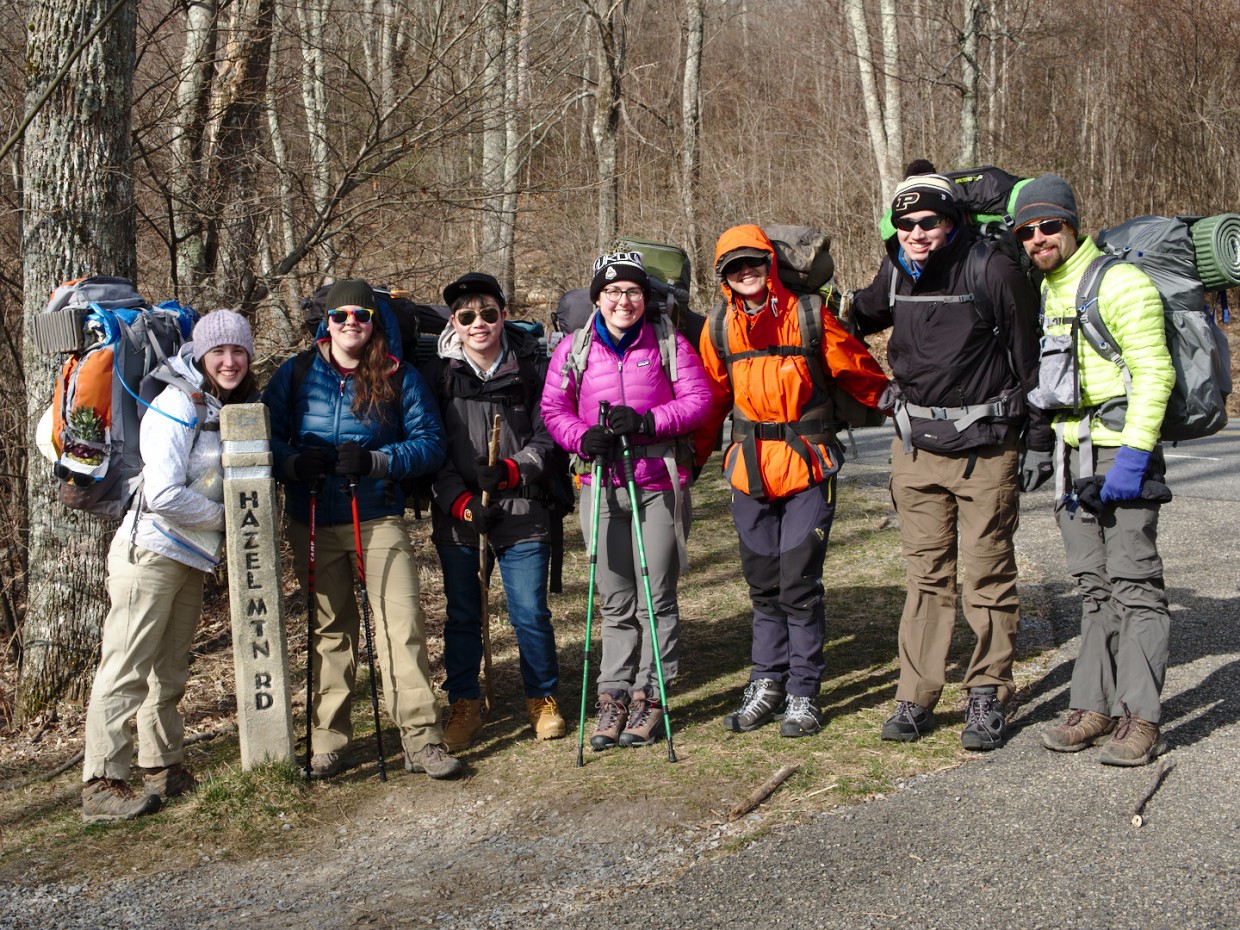




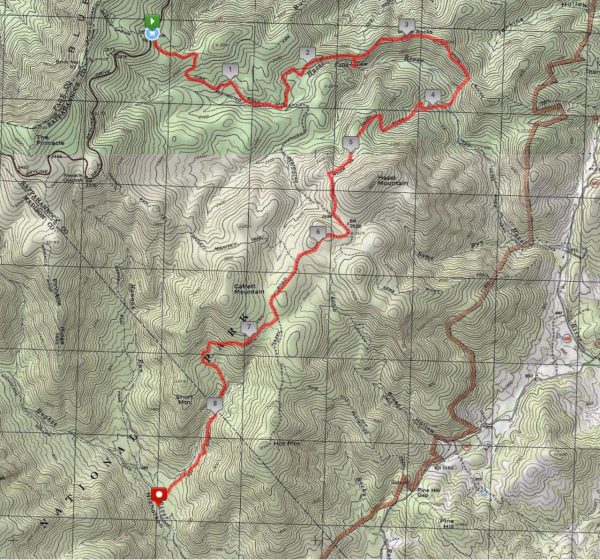







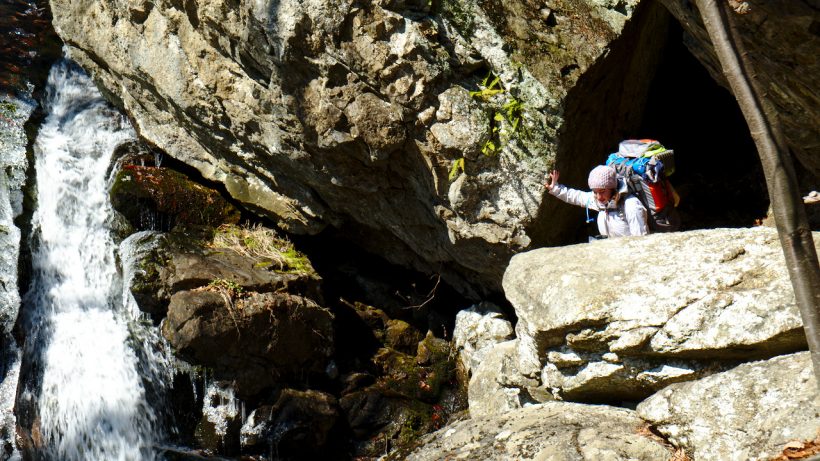
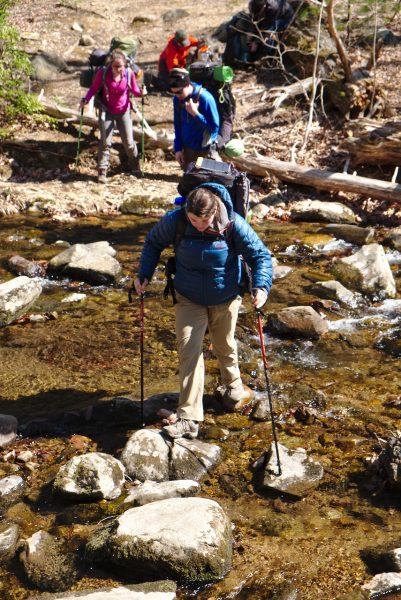
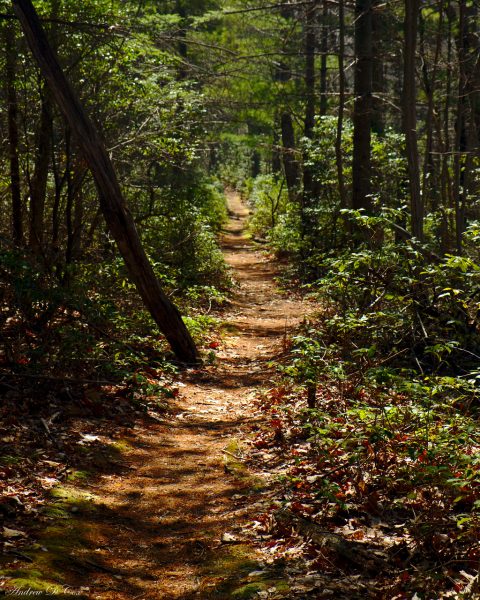
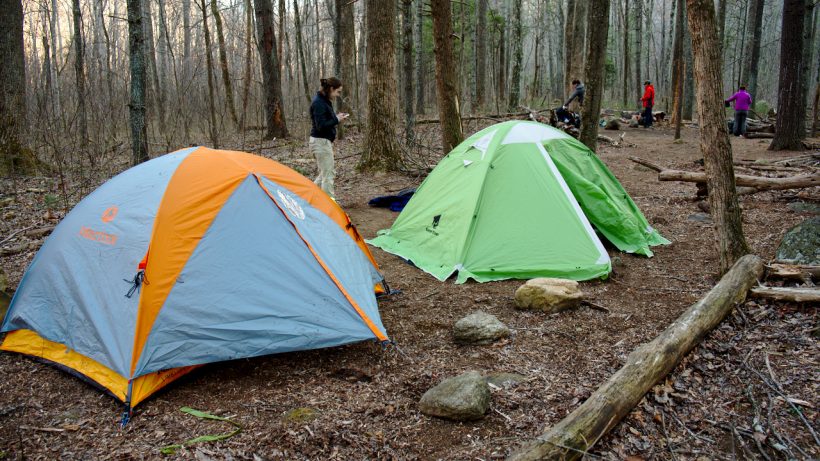






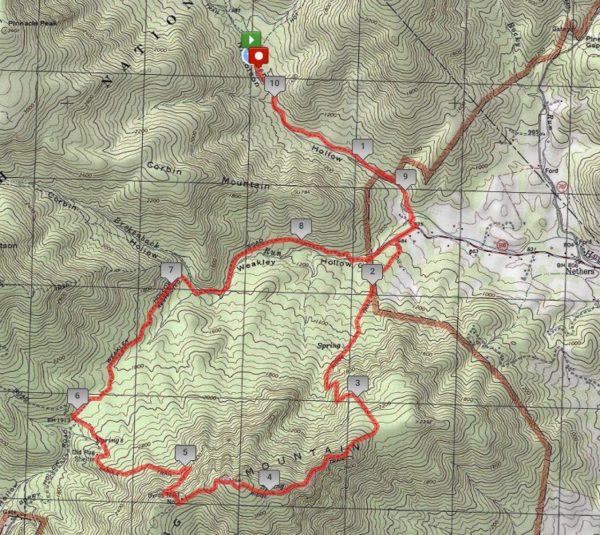












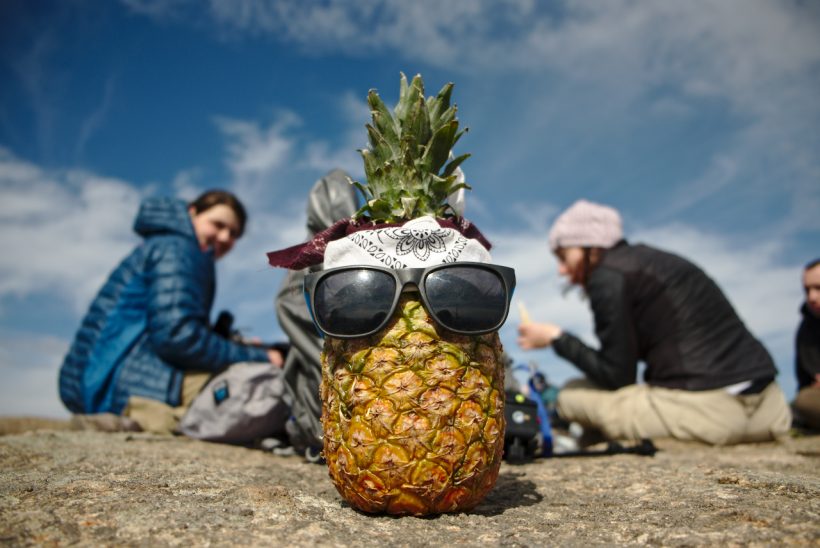




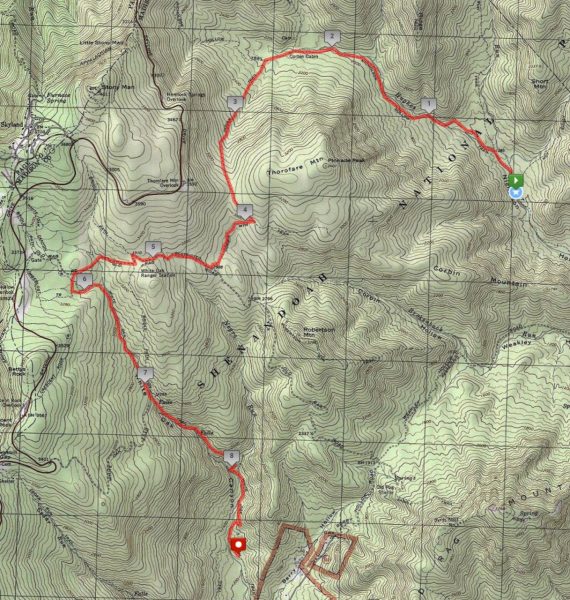






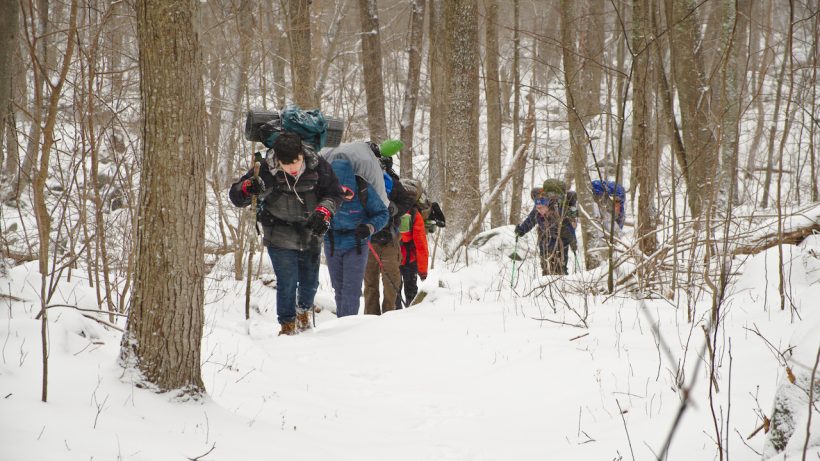









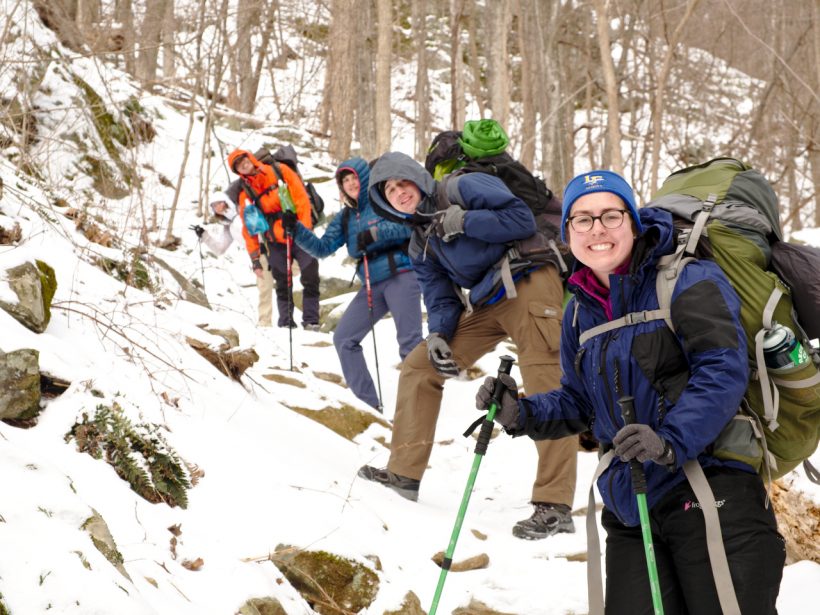




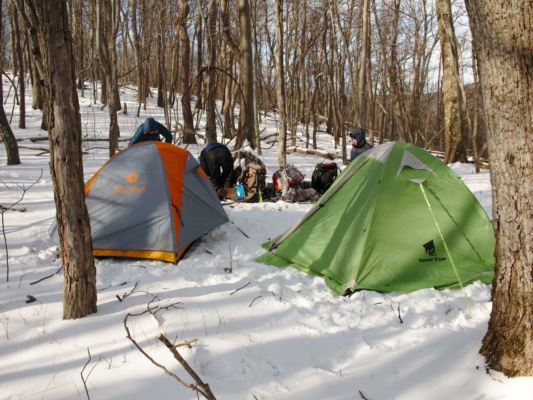




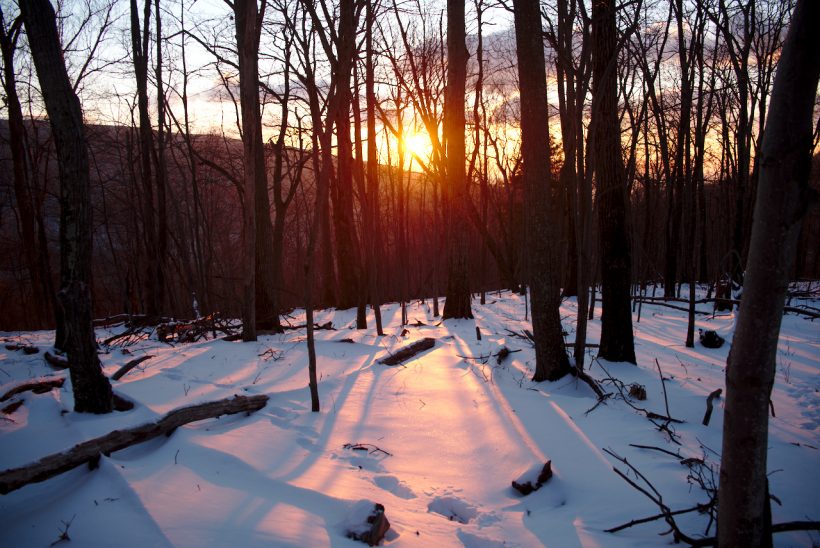
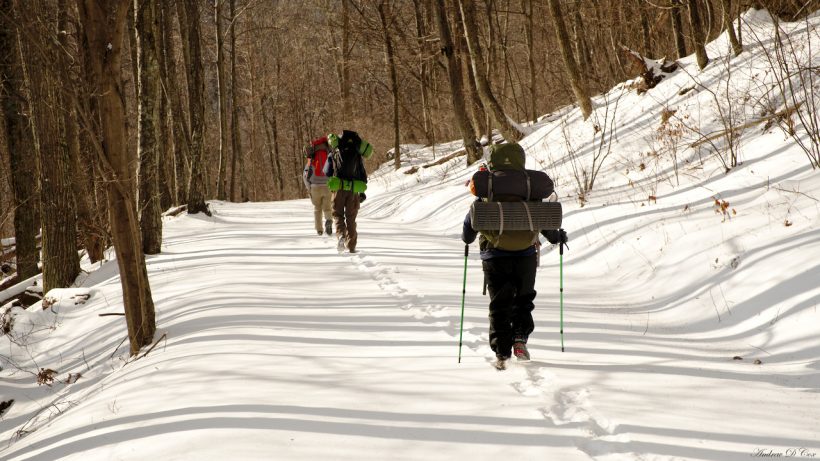
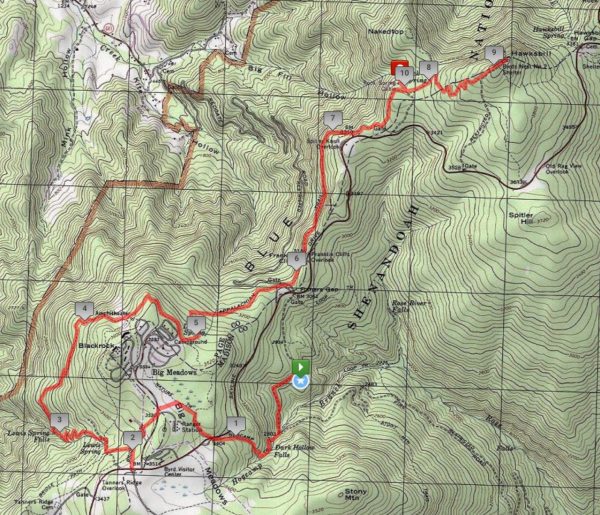








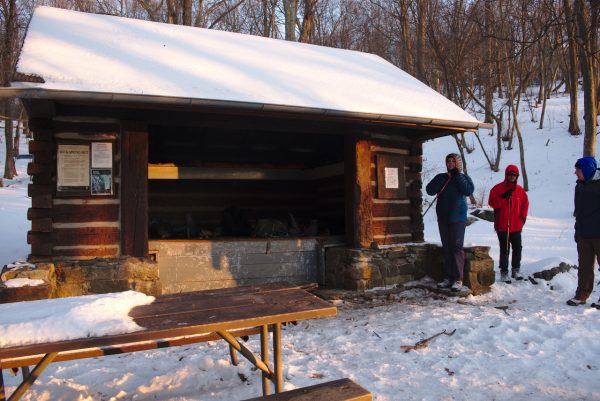
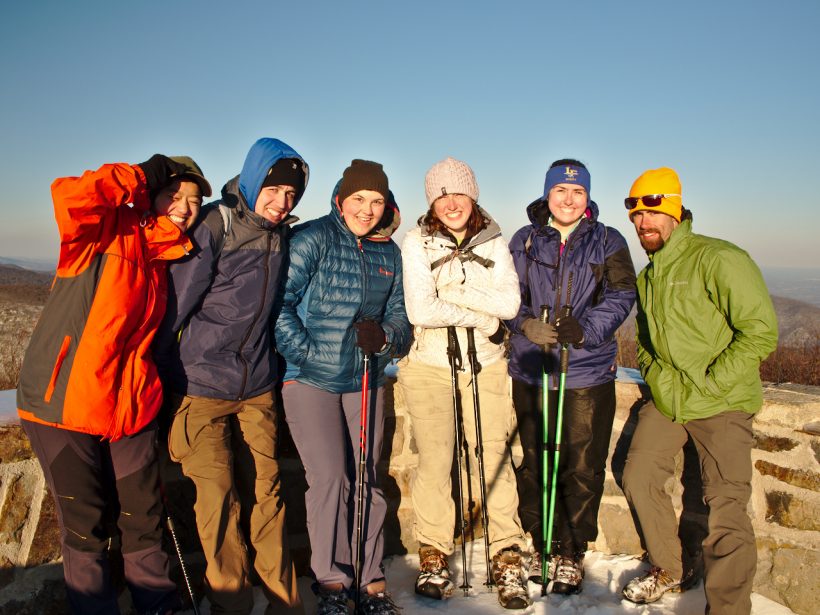
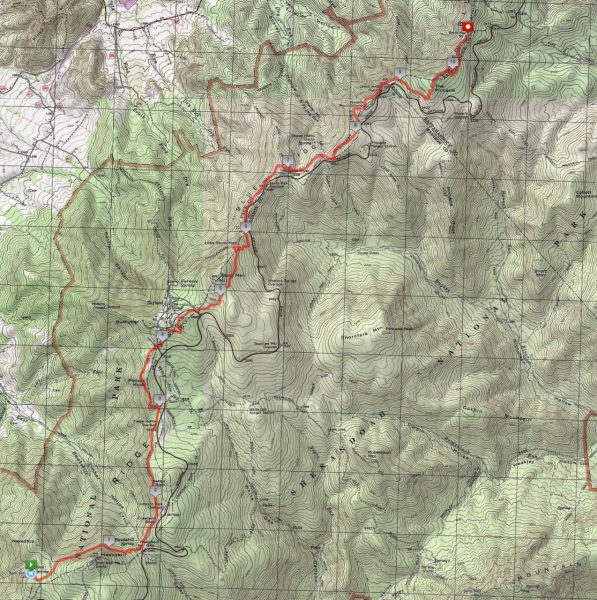



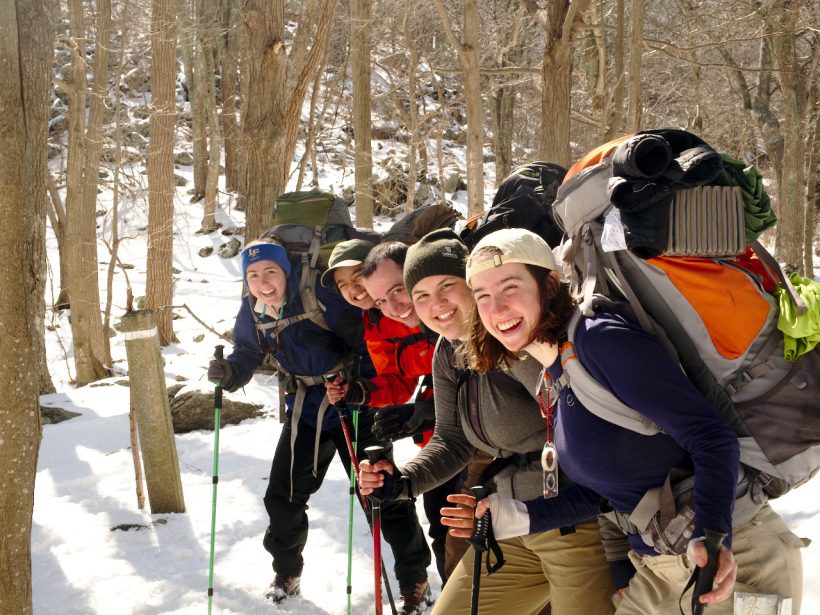






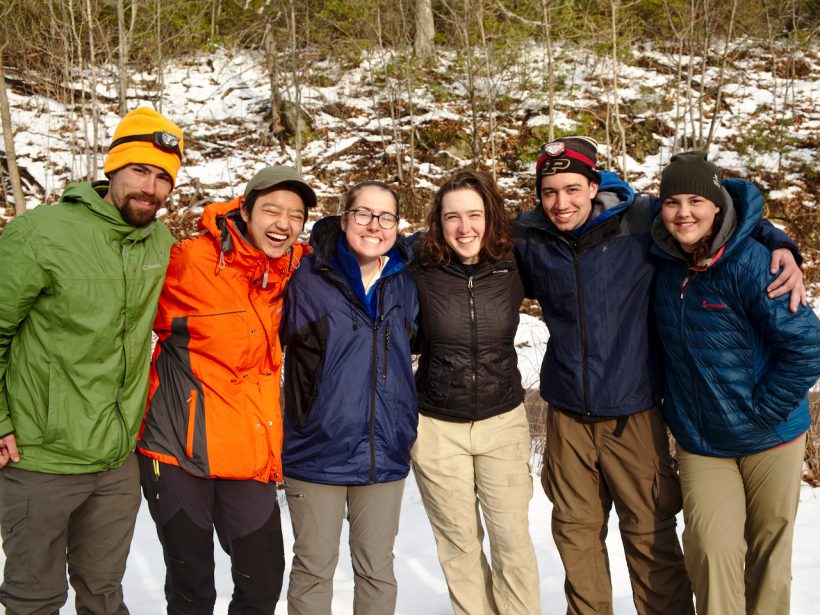
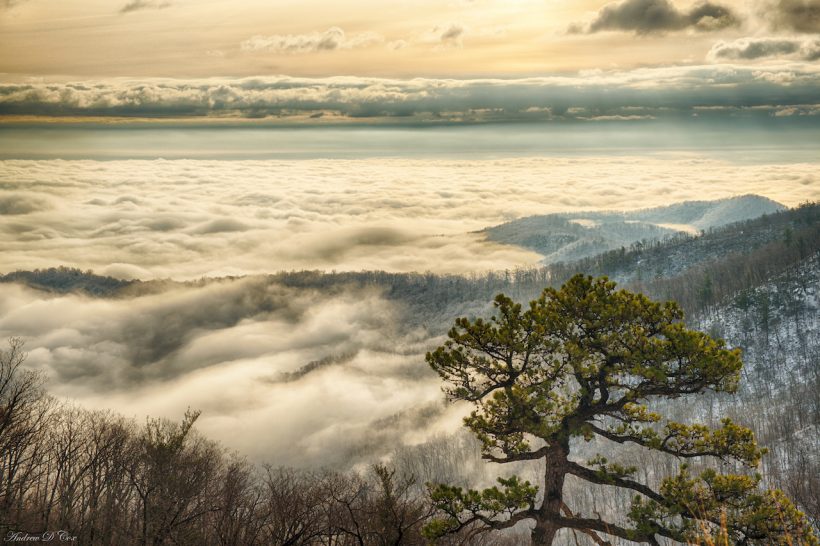

Judith Roeder 4 April 2017
You were able to see some really beautiful country! The camera shots and the people made the whole thing great to read about.
Andrew 4 April 2017
Judith – Thank you! I’m glad you enjoyed the photos and stories.
CanoeMike (in south Louisiana) 6 April 2017
Spring Break! Wow, what an adventure! Nice scenic views and happy smiling faces. Great pics and write-up.